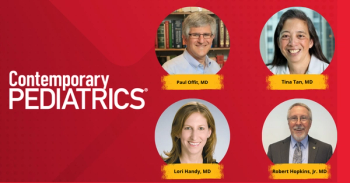
- Consultant for Pediatricians Vol 9 No 9
- Volume 9
- Issue 9
Hematemesis Caused by Esophageal Duplication
A17-month-old girl was hospitalized 3 weeks earlier because of gagging and retching emesis that contained blood-streaked mucus. Her symptoms persisted and she was transferred to a tertiary care center for further workup.
A 17-month-old girl was hospitalized 3 weeks earlier because of gagging and retching emesis that contained blood-streaked mucus. Her symptoms persisted and she was transferred to a tertiary care center for further workup.
The child was born at 35 weeks' gestation after a pregnancy complicated by polyhydramnios. She spent 1 month in the neonatal ICU for feeding difficulties (gurgling sounds during feedings, significant pooling of secretions, and aspiration documented on a video swallow study) and failure to thrive. Results of an upper GI series showed severe gastroesophageal reflux. Findings on an echocardiogram to evaluate ventricular function suggested the presence of a mass within the esophagus compressing the left atrium. An axial CT scan of the chest showed an abnormally thickened, dilated esophagus.
On admission, results of a second GI series revealed a filling defect (
The patient underwent surgical resection of a large (5.0 × 2.0 × 2.0-cm), tubular, pedunculated mass. A smooth-surfaced cyst, with a thin (0.1-cm) wall filled with white mucoid fluid was found. Histological examination revealed focal areas of squamous epithelium and predominantly gastric mucosa (both cardiac and antral mucosa) with congestion in the lamina propria (
GI duplications are rare congenital malformations that can be found in any part of the GI tract, the most common location being the small bowel.1 Esophageal duplications account for only 10% to 20% of all GI duplications and affect about 1 of 8000 persons.2 Duplications present in 3 major forms: cysts, diverticula, and tubular malformations.2 Histological features include attachment of the lesion to the GI tract, presence of a muscular layer, and a digestive mucosa.1
Cervical esophageal duplications are rare in children.1,3,4 The finding of gastric heterotopic tissue in this child is unique. Heterotopic gastric mucosa has been associated with other esophageal lesions in adults.5,6 Also referred to as a cervical inlet patch, heterotopic gastric mucosa of the cervical esophagus usually appears as a flat or slightly raised, well-circumscribed, salmoncolored patch.7 Upper GI endoscopy can confirm the diagnosis, although, as shown here, these lesions can be difficult to diagnose preoperatively.
References:
REFERENCES:
1.
Vasseur Maurer S, Schwab G, Osterheld MC, et al. A 16-month-old boy vomits a double tongue: intraluminal duplication of the cervical esophagus in children.
Dis Esophagus
. 2008;21:186-188.
2.
Isaacson PG. Duplication cysts. In: Noffsinger AE, Stemmermann GN, Lantz EP, eds.
Gastrointestinal Pathology. An Atlas and Text
. 3rd ed. Philadelphia: Lippincott; 2008:24-26.
3.
Billmire DF, Allen JE. Duplication of the cervical esophagus in children.
J Pediatr Surg
. 1995;30:1498-1499.
4.
Sharma KK, Ranka P, Meratiya S. Isolated cervical esophagus duplication: a rarity.
J Pediatr Surg
. 2005;40:591-592.
5.
Oguma J, Ozawa S, Omori T, et al. EMR of a hyperplastic polyp arising in ectopic gastric mucosa in the cervical esophagus: case report.
Gastrointest Endosc
. 2005;61:335-338.
6.
Schmulewitz N, Tobias J, Singh P. Hyperplastic polyp arising from heterotopic gastric epithelium in the esophagus.
Gastrointest Endosc
. 2007;66:1220-1222.
7.
Azar C, Jamali F, Tamim H, et al. Prevalence of endoscopically identified heterotopic gastric mucosa in the proximal esophagus: endoscopist dependent?
J Clin Gastroenterol
. 2007;41:468-471.
Articles in this issue
over 15 years ago
Hypopigmentation Secondary to Eczemaover 15 years ago
Infant With Multiple Birthmarks and Hypertrophic Left Armover 15 years ago
Eczema Herpeticum With MRSA Superinfectionover 15 years ago
A New Zip in Playground InjuriesNewsletter
Access practical, evidence-based guidance to support better care for our youngest patients. Join our email list for the latest clinical updates.







